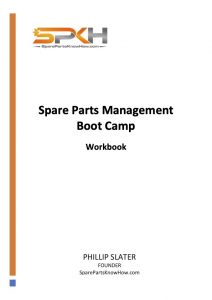Topic Area: Online Boot Camp

The Online Boot Camp is a team-based delivery of our Must Know course, designed to build a shared understanding of the fundamentals and drive better results across your organization.
Why Choose the Online Boot Camp?
- Instructor-Led, 100% Online: Delivered live by experts, this team-oriented training ensures an engaging, interactive experience.
- Team-Focused: Equip your team with a common approach and consistent insights to eliminate misalignment and confusion.
- Effective Coordination: Reduce friction, improve decision-making, and foster collaboration to make change implementation smoother.
Why Is This Course Important?
When team members lack a shared understanding of spare parts inventory management, results are often subpar.
Misalignment can lead to:
- Emotion-based decisions – resulting in unnecessary overstocking.
- Excessive obsolete inventory – due to poor management of end-of-life stock.
- Poor coordination – driving up expediting costs or causing missed maintenance windows.
- Operational silos – breeding inefficiency and finger-pointing..
But it doesn’t have to be this way.
Our Online Boot Camp brings your team together, providing a unified perspective on spare parts management.
This course addresses the four most challenging aspects of spare parts management:
1. What to stock
Learn how to identify critical inventory with our planning horizon, 7-question framework, and clear approaches for determining what belongs in your inventory.
2. How many to stock
Discover a simple, actionable method to calculate optimal holding levels in just minutes, ensuring you avoid overstocking or shortages.
3. Best practices that work
Dive into the 7 proven best practices we’ve identified through extensive research—strategies that consistently deliver better results.
4. Minimizing disposal and obsolescence
Master strategies for both first-time-buy and end-of-life inventory management to avoid getting stuck with unnecessary or outdated stock.
– Align your team with a single source of truth to eliminate confusion.
– Improve coordination and communication across departments.
– Equip everyone with the skills to make smarter, data-driven decisions.
– Reduce overstocking, obsolescence, and costly mistakes.
Don’t let misalignment hold your team back.
Enroll your team in the Spare Parts Management Online Boot Camp today and unlock a more efficient, collaborative, and effective approach to spare parts inventory management.
Ali Abrar
QAFCO
Khalid Majeed
Shandong Electric Power
Jason Ashby
The Shepherd Color Company
 This is an intensive, instructor led, 100% online, group or team training program that teaches participants the fundamentals of spare parts inventory management.
This is an intensive, instructor led, 100% online, group or team training program that teaches participants the fundamentals of spare parts inventory management.
Live Online Sessions:
- The course involves 4 interactive live online sessions over 4 consecutive weeks.
- Each week there is a 90-minute, live on-line session with the course facilitator, Phillip Slater.
Weekly Individual Study:
- Each module consists of reading, videos, and exercises. The participants review this content before each online session.
- Expected ‘homework’ time averages at approximately 60-90 minutes per week.
- The online session then acts as a tutorial to clarify understanding and answer questions.
Online Group Discussion
- The participants can engage in a discussion with other participants, and they can ask questions of the course facilitator.
- This enables them to reach a common understanding of the issues and solutions.
Extensive Workbook:
- There is a 26-page workbook to guide students through the course that includes all the exercises.
- The workbook also helps participants develop a personal action plan for execution in your business.
Assessment
- Students that attend all four sessions will receive a certificate acknowledging their participation.
Download a copy of the Boot Camp Training Plan
No email required.
Spare parts management is a ‘team sport’.That is, it takes a team of people to produce effective results in terms of stock holding levels, availability, accuracy, and cost.
You can either assist them in working together or force them to work it out on their own.”
Online Boot Camp is right for you.
This course is facilitated by: Phillip Slater